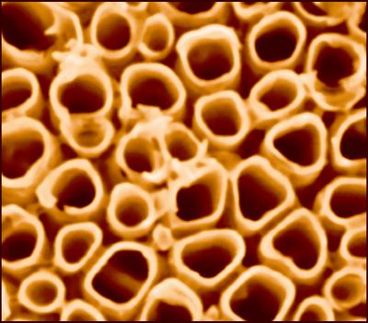Breaking down pollutants with sunlight
Carbon-doped titanium dioxide as an effective photocatalyst
Advertisement
The sun is a virtually inexhaustible source of energy, which isn't just useful for the production of electrical energy (solar cells). For example, when converted into chemical energy, it can be used to break down pollutants. Researchers at the University of Erlangen-Nürnberg have now developed a new titanium dioxide based semiconductor photocatalyst that can use a larger fraction of sunlight than those used up until now, making it work more efficiently.
In semiconductor photocatalysis, the absorption of light energy causes the formation of charge carriers on the surface of the semiconductor : electrons or "holes". The latter are places where electrons are missing, so they can be considered as positive-charge carriers. These can be captured and used for electron transfer to or from pollutant molecules. This initiates the decomposition reactions.
Titanium dioxide has also demonstrated its usefulness as a photocatalyst, such as in self-cleaning paints. However, titanium dioxide can only make use of the UV portion of sunlight, which is only 2-3%.
Horst Kisch and Shanmugasundaram Sakthivel wanted to sensitize titanium dioxide to the much broader visible portion of the spectrum. They thus doped it with other atoms, and samples with nitrogen-doped titanium dioxide initially showed success. The material was prepared by the hydrolysis of titanium tetrachloride with organic nitrogen bases. The final step involves heating to 400 °C. The researchers determined that heating for too long leads to a titanium dioxide material that contains no nitrogen at all; it has carbon instead. It is also much better; under artificial visible light, the carbon-doped catalysts break down chlorophenol five times more efficiently than the nitrogen-doped analogues.
The new production method for the carbon-doped titanium dioxides is simple, highly reproducible, and more broadly applicable than the classic oxidation of titanium foil in a natural gas flame. In addition, the titanium dioxide formed has a different crystal structure, and thus a different range of properties than the classic version.
"Our new photocatalysts are powerful," says Kisch, "even in diffuse interior daylight, they break down dissolved pollutants such as chlorophenol and azo dyes, as well as gas-phase pollutants such as acetaldehyde, benzene, and carbon monoxide, with no problems."
Most read news
Topics
Organizations
Other news from the department science

Get the chemical industry in your inbox
By submitting this form you agree that LUMITOS AG will send you the newsletter(s) selected above by email. Your data will not be passed on to third parties. Your data will be stored and processed in accordance with our data protection regulations. LUMITOS may contact you by email for the purpose of advertising or market and opinion surveys. You can revoke your consent at any time without giving reasons to LUMITOS AG, Ernst-Augustin-Str. 2, 12489 Berlin, Germany or by e-mail at revoke@lumitos.com with effect for the future. In addition, each email contains a link to unsubscribe from the corresponding newsletter.


























































